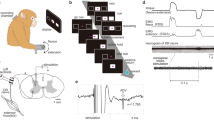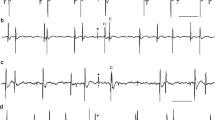Summary
-
1.
The response of hindleg flexor tibiae motoneurons to visual, auditory and proprioceptive stimuli, and to combinations of these stimuli, was recorded intracellularly in the locustLocusta migratoria.
-
2.
Visual and auditory stimuli when presented alone or together rarely evoked any postsynaptic potentials in the flexor motoneurons. However, the combination of proprioceptive input with either visual or auditory stimuli resulted in a high probability of large IPSPs occurring in response to either the visual or the auditory stimulus. From these data we conclude there are strong polysynaptic inhibitory pathways from the auditory and visual systems to the hindleg flexor tibiae motoneurons and that transmission through these pathways is gated by input from hindleg proprioceptors.
-
3.
The features of the IPSPs evoked by visual and auditory stimuli in the presence of proprioceptive input were identical suggesting that all IPSPs were produced by activation of a single interneuron. Intracellular recording from an identified interneuron (the M-neuron) known to make strong inhibitory connections to flexor motoneurons, and known to receive visual, auditory and proprioceptive input, showed that the probabilities of evoking spikes in this interneuron and of evoking IPSPs in flexor motoneurons were strongly correlated. From these and other data we conclude that the M-neuron is the site of proprioceptive gating of inhibitory transmission from both the visual and auditory systems to flexor motoneurons.
-
4.
We speculate that the function of proprioceptive gating is to enable visual and auditory stimuli to trigger a jump, and to ensure that external stimuli do not inhibit flexor activity at times when the animal is not prepared to jump.
Similar content being viewed by others
Abbreviations
- DCMD :
-
descending contralateral movement detector
- EMG :
-
electromyogram
References
Bässler U (1968) Zur Steuerung des Springens bei der WanderheuschreckeSchistocerca gregaria. Kybernetik 4:112
Berkinblit MB, Deliagina TG, Feldman AG, Gelfand IM, Orlovsky GN (1978) Generation of scratching. 2. Nonregular regimes of generation. J Neurophysiol 41:1058–1069
Davis WJ (1976) Behavioral and neuronal plasticity in mollusks. In: Fentress JC (ed) Simpler networks and behavior. Sinauer, Sunderland, pp 224–238
Grillner S, Rossignol S (1978) Contralateral reflex reversal controlled by limb position in the acute spinal cat injected with clonidine i.v. Brain Res 144:411–414
Heitler WJ, Burrows M (1977a) The locust jump. 1. The motor programme. J Exp Biol 66:203–220
Heitler WJ, Burrows M (1977b) The locust jump. 2. Neural circuits of the motor programme. J Exp Biol 66:221–242
Kandel ER (1976) Cellular basis of behavior. Freeman, San Francisco
Kandel ER, Krasne FB, Strumwasser F, Truman JW (1979) Cellular mechanisms in the selection and modulation of behavior. Neurosci Res Prog Bull 17(4):521–710
Lundberg A (1979) Multisensory control of spinal reflex pathways. Prog Brain Res 50:11–28
Pearson KG, Goodman CS (1979) Correlation of variability in structure with variability in synaptic connections of an identified interneuron in locusts. J Comp Neurol 184:141–166
Pearson KG, Goodman CS (1981) Presynaptic inhibition of transmission from identified interneurons in the locust central nervous system. J Neurophysiol 45:501–515
Pearson KG, Robertson RM (1981) Interneurons coactivating hindleg flexor and extensor motoneurons in the locust. J Comp Physiol 144:391–400
Pearson KG, Heitler WJ, Steeves JD (1980) Triggering of locust jump by multimodal inhibitory interneurons. J Neurophysiol 43:257–278
Stephens JA, Garnett R, Buller NP (1978) Reversal of recruitment order of single motor units produced by cutaneous stimulation during voluntary muscle contraction in man. Nature 272:362–364
Stewart WW (1978) Functional connections between cells revealed by dye-coupling with highly fluorescent naphthalamide tracer. Cell 14:741–759
Author information
Authors and Affiliations
Rights and permissions
About this article
Cite this article
Steeves, J.D., Pearson, K.G. Proprioceptive gating of inhibitory pathways to hindleg flexor motoneurons in the locust. J. Comp. Physiol. 146, 507–515 (1982). https://doi.org/10.1007/BF00609447
Accepted:
Issue Date:
DOI: https://doi.org/10.1007/BF00609447




